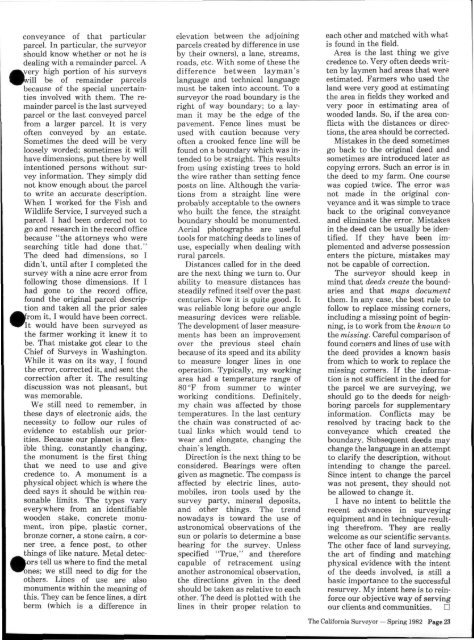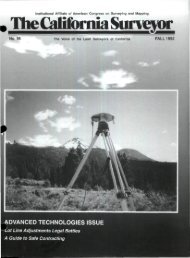Institutional Affiliate of American Congress on Surveying - CLSA
Institutional Affiliate of American Congress on Surveying - CLSA
Institutional Affiliate of American Congress on Surveying - CLSA
You also want an ePaper? Increase the reach of your titles
YUMPU automatically turns print PDFs into web optimized ePapers that Google loves.
c<strong>on</strong>veyance <str<strong>on</strong>g>of</str<strong>on</strong>g> that particular<br />
parcel. In particular, the surveyor<br />
should know whether or not he is<br />
dealing with a remainder parcel. A<br />
^very high porti<strong>on</strong> <str<strong>on</strong>g>of</str<strong>on</strong>g> his surveys<br />
ill be <str<strong>on</strong>g>of</str<strong>on</strong>g> remainder parcels<br />
because <str<strong>on</strong>g>of</str<strong>on</strong>g> the special uncertainties<br />
involved with them. The remainder<br />
parcel is the last surveyed<br />
parcel or the last c<strong>on</strong>veyed parcel<br />
from a larger parcel. It is very<br />
<str<strong>on</strong>g>of</str<strong>on</strong>g>ten c<strong>on</strong>veyed by an estate.<br />
Sometimes the deed will be very<br />
loosely worded; sometimes it will<br />
have dimensi<strong>on</strong>s, put there by well<br />
intenti<strong>on</strong>ed pers<strong>on</strong>s without survey<br />
informati<strong>on</strong>. They simply did<br />
not know enough about the parcel<br />
to write an accurate descripti<strong>on</strong>.<br />
When I worked for the Fish and<br />
Wildlife Service, I surveyed such a<br />
parcel. I had been ordered not to<br />
go and research in the record <str<strong>on</strong>g>of</str<strong>on</strong>g>fice<br />
because "the attorneys who were<br />
searching title had d<strong>on</strong>e that."<br />
The deed had dimensi<strong>on</strong>s, so I<br />
didn't, until after I completed the<br />
survey with a nine acre error from<br />
following those dimensi<strong>on</strong>s. If I<br />
had g<strong>on</strong>e to the record <str<strong>on</strong>g>of</str<strong>on</strong>g>fice,<br />
found the original parcel descripti<strong>on</strong><br />
and taken all the prior sales<br />
m<br />
rom it, I would have been correct.<br />
It would have been surveyed as<br />
the farmer working it knew it to<br />
be. That mistake got clear to the<br />
Chief <str<strong>on</strong>g>of</str<strong>on</strong>g> Surveys in Washingt<strong>on</strong>.<br />
While it was <strong>on</strong> its way, I found<br />
the error, corrected it, and sent the<br />
correcti<strong>on</strong> after it. The resulting<br />
discussi<strong>on</strong> was not pleasant, but<br />
was memorable.<br />
We still need to remember, in<br />
these days <str<strong>on</strong>g>of</str<strong>on</strong>g> electr<strong>on</strong>ic aids, the<br />
necessity to follow our rules <str<strong>on</strong>g>of</str<strong>on</strong>g><br />
evidence to establish our priorities.<br />
Because our planet is a flexible<br />
thing, c<strong>on</strong>stantly changing,<br />
the m<strong>on</strong>ument is the first thing<br />
that we need to use and give<br />
credence to. A m<strong>on</strong>ument is a<br />
physical object which is where the<br />
deed says it should be within reas<strong>on</strong>able<br />
limits. The types vary<br />
everywhere from an identifiable<br />
wooden stake, c<strong>on</strong>crete m<strong>on</strong>ument,<br />
ir<strong>on</strong> pipe, plastic comer,<br />
br<strong>on</strong>ze comer, a st<strong>on</strong>e cairn, a corner<br />
tree, a fence post, to other<br />
things <str<strong>on</strong>g>of</str<strong>on</strong>g> like nature. Metal detecors<br />
tell us where to find the metal<br />
'<strong>on</strong>es; we still need to dig for the<br />
others. Lines <str<strong>on</strong>g>of</str<strong>on</strong>g> use are also<br />
m<strong>on</strong>uments within the meaning <str<strong>on</strong>g>of</str<strong>on</strong>g><br />
this. They can be fence lines, a dirt<br />
berm (which is a difference in<br />
elevati<strong>on</strong> between the adjoining<br />
parcels created by difference in use<br />
by their owners), a lane, streams,<br />
roads, etc. With some <str<strong>on</strong>g>of</str<strong>on</strong>g> these the<br />
difference between layman's<br />
language and technical language<br />
must be taken into account. To a<br />
surveyor the road boundary is the<br />
right <str<strong>on</strong>g>of</str<strong>on</strong>g> way boundary; to a layman<br />
it may be the edge <str<strong>on</strong>g>of</str<strong>on</strong>g> the<br />
pavement. Fence hues must be<br />
used with cauti<strong>on</strong> because very<br />
<str<strong>on</strong>g>of</str<strong>on</strong>g>ten a crooked fence hne will be<br />
found <strong>on</strong> a boundary which was intended<br />
to be straight. This results<br />
from using existing trees to hold<br />
the wire rather than setting fence<br />
posts <strong>on</strong> line. Although the variati<strong>on</strong>s<br />
from a straight line were<br />
probably acceptable to the owners<br />
who built the fence, the straight<br />
boundary should be m<strong>on</strong>umented.<br />
Aerial photographs are useful<br />
tools for matching deeds to hnes <str<strong>on</strong>g>of</str<strong>on</strong>g><br />
use, especially when dealing with<br />
mral parcels.<br />
Distances called for in the deed<br />
are the next thing we turn to. Our<br />
abihty to measure distances has<br />
steadily refined itself over the past<br />
centuries. Now it is quite good. It<br />
was reliable l<strong>on</strong>g before our angle<br />
measuring devices were reliable.<br />
The development <str<strong>on</strong>g>of</str<strong>on</strong>g> laser measurements<br />
has been an improvement<br />
over the previous steel chain<br />
because <str<strong>on</strong>g>of</str<strong>on</strong>g> its speed and its ability<br />
to measure l<strong>on</strong>ger hnes in <strong>on</strong>e<br />
operati<strong>on</strong>. Typically, my working<br />
area had a temperature range <str<strong>on</strong>g>of</str<strong>on</strong>g><br />
80 °F from summer to winter<br />
working c<strong>on</strong>diti<strong>on</strong>s. Definitely,<br />
my chain was affected by those<br />
temperatures. In the last century<br />
the chain was c<strong>on</strong>structed <str<strong>on</strong>g>of</str<strong>on</strong>g> actual<br />
links which would tend to<br />
wear and el<strong>on</strong>gate, changing the<br />
chain's length.<br />
Directi<strong>on</strong> is the next thing to be<br />
c<strong>on</strong>sidered. Bearings were <str<strong>on</strong>g>of</str<strong>on</strong>g>ten<br />
given as magnetic. The compass is<br />
affected by electric lines, automobiles,<br />
ir<strong>on</strong> tools used by the<br />
survey party, mineral deposits,<br />
and other things. The trend<br />
nowadays is toward the use <str<strong>on</strong>g>of</str<strong>on</strong>g><br />
astr<strong>on</strong>omical observati<strong>on</strong>s <str<strong>on</strong>g>of</str<strong>on</strong>g> the<br />
sun or polaris to determine a base<br />
bearing for the survey. Unless<br />
specified "True," and therefore<br />
capable <str<strong>on</strong>g>of</str<strong>on</strong>g> retracement using<br />
another astr<strong>on</strong>omical observati<strong>on</strong>,<br />
the directi<strong>on</strong>s given in the deed<br />
should be taken as relative to each<br />
other. The deed is plotted with the<br />
lines in their proper relati<strong>on</strong> to<br />
each other and matched with what<br />
is found in the field.<br />
Area is the last thing we give<br />
credence to. Very <str<strong>on</strong>g>of</str<strong>on</strong>g>ten deeds written<br />
by laymen had areas that were<br />
estimated. Farmers who used the<br />
land were very good at estimating<br />
the area in fields they worked and<br />
very poor in estimating area <str<strong>on</strong>g>of</str<strong>on</strong>g><br />
wooded lands. So, if the area c<strong>on</strong>flicts<br />
with the distances or directi<strong>on</strong>s,<br />
the area should be corrected.<br />
Mistakes in the deed sometimes<br />
go back to the original deed and<br />
sometimes are introduced later as<br />
copying errors. Such an error is in<br />
the deed to my farm. One course<br />
was copied twice. The error was<br />
not made in the original c<strong>on</strong>veyance<br />
and it was simple to trace<br />
back to the original c<strong>on</strong>veyance<br />
and eliminate the error. Mistakes<br />
in the deed can be usually be identified.<br />
If they have been implemented<br />
and adverse possessi<strong>on</strong><br />
enters the picture, mistakes may<br />
not be capable <str<strong>on</strong>g>of</str<strong>on</strong>g> correcti<strong>on</strong>.<br />
The surveyor should keep in<br />
mind that deeds create the boundaries<br />
and that maps document<br />
them. In any case, the best rule to<br />
follow to replace missing corners,<br />
including a missing point <str<strong>on</strong>g>of</str<strong>on</strong>g> beginning,<br />
is to work from the known to<br />
the missing. Careful comparis<strong>on</strong> <str<strong>on</strong>g>of</str<strong>on</strong>g><br />
found corners and lines <str<strong>on</strong>g>of</str<strong>on</strong>g> use with<br />
the deed provides a known basis<br />
from which to work to replace the<br />
missing corners. If the informati<strong>on</strong><br />
is not sufficient in the deed for<br />
the parcel we are surveying, we<br />
should go to the deeds for neighboring<br />
parcels for supplementary<br />
informati<strong>on</strong>. C<strong>on</strong>flicts may be<br />
resolved by tracing back to the<br />
c<strong>on</strong>veyance which created the<br />
boundary. Subsequent deeds may<br />
change the language in an attempt<br />
to clarify the descripti<strong>on</strong>, without<br />
intending to change the parcel.<br />
Since intent to change the parcel<br />
was not present, they should not<br />
be allowed to change it.<br />
I have no intent to belittle the<br />
recent advances in surveying<br />
equipment and in technique resulting<br />
therefrom. They are really<br />
welcome as our scientific servants.<br />
The other face <str<strong>on</strong>g>of</str<strong>on</strong>g> land surveying,<br />
the art <str<strong>on</strong>g>of</str<strong>on</strong>g> finding and matching<br />
physical evidence with the intent<br />
<str<strong>on</strong>g>of</str<strong>on</strong>g> the deeds involved, is still a<br />
basic importance to the successful<br />
resurvey. My intent here is to reinforce<br />
our objective way <str<strong>on</strong>g>of</str<strong>on</strong>g> serving<br />
our clients and communities. •<br />
The California Surveyor — Spring 1982 Page 23

















